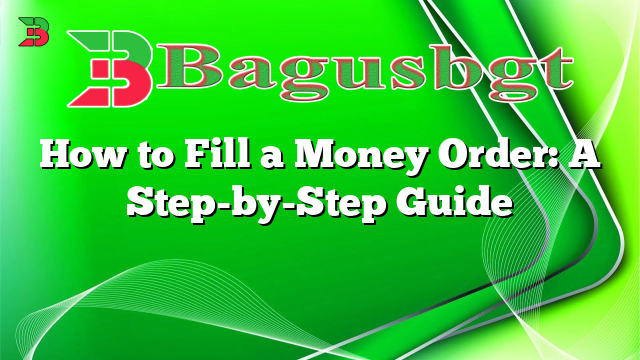Hello readers! Are you unsure about how to fill out a money order? Don’t worry, we’ve got you covered. In this comprehensive guide, we will walk you through the process of filling out a money order step by step. Whether you’re sending money to a friend or making a payment, this article will provide you with all the information you need. So let’s get started!
1. Gather the Required Information
Before you begin filling out a money order, make sure you have all the necessary information. You will need the recipient’s full name, address, and the exact amount you wish to send. Additionally, it’s important to have cash or a debit card to cover the cost of the money order plus any associated fees.
2. Choose a Reliable Provider
When it comes to money orders, it’s crucial to select a reputable provider. Look for well-known institutions such as banks, post offices, or trusted retail locations. Research the fees charged by different providers and choose the one that suits your needs and budget.
3. Fill Out the “Pay To” Field
On the money order, you will find a field labeled “Pay To” or “Payee.” This is where you write the name of the person or business to whom you are sending the money. Make sure to write the name exactly as it appears on the recipient’s identification to avoid any complications.
4. Provide Your Information
In the “From” or “Sender” field, you need to provide your own information. Write your full name, address, and any other required details as specified by the money order provider. Double-check your information to ensure accuracy.
5. Include a Memo (Optional)
Some money orders have a memo line where you can include additional information. This is optional but can be useful if you want to provide a reference for the payment, such as an invoice number or account information. If you don’t need to include any additional details, you can leave this field blank.
6. Sign the Money Order
Before submitting the money order, it’s essential to sign it. Look for the designated “Purchaser’s Signature” line and sign your name exactly as it appears on your identification. Failure to sign the money order may render it invalid, so don’t forget this crucial step.
7. Detach the Receipt
After completing all the necessary fields and signing the money order, tear off the receipt portion along the perforated line. This receipt serves as proof of purchase and includes the money order’s tracking number, which can be helpful in case of any issues or inquiries.
8. Keep Your Receipt Secure
Once you’ve detached the receipt, it’s important to keep it safe and secure. Treat it like you would treat cash, as losing the receipt could make it difficult to track or cancel the money order if necessary.
9. Send or Deliver the Money Order
Now that your money order is ready, you can send it to the recipient or deliver it in person. Ensure that it reaches the intended recipient through a secure method such as certified mail or hand delivery.
10. Track the Money Order (Optional)
If you want to track the progress of your money order, you can use the tracking number provided on the receipt. Visit the money order provider’s website or contact their customer service to inquire about the status of your money order.
Alternative Method: Online Money Transfers
In addition to traditional money orders, there is an alternative method for sending money – online money transfers. With the advancement of technology, various online platforms and mobile apps now allow you to send money quickly and conveniently. These platforms often require you to create an account, link your bank account or credit card, and provide the recipient’s information. Online money transfers offer the advantage of instant delivery, but it’s crucial to choose a trusted platform and be aware of any associated fees.
| Field | Description |
|---|---|
| Pay To | Write the name of the person or business you are sending the money to |
| From | Provide your full name, address, and any other required details |
| Memo | Optional field to include additional information or reference for the payment |
| Purchaser’s Signature | Sign the money order using your name as it appears on your identification |
Conclusion
Filling out a money order may seem daunting at first, but by following these step-by-step instructions, it becomes a simple and straightforward process. Remember to gather all the necessary information, choose a reliable provider, and double-check your entries before submitting the money order. Whether you opt for a traditional money order or explore the alternative of online money transfers, both methods provide secure ways to send funds to individuals or businesses. By understanding the process and taking the necessary precautions, you can ensure that your money order reaches the intended recipient safely and efficiently.
Frequently Asked Questions (FAQ)
Q: Can I pay for a money order with a credit card?
A: Some providers may accept credit cards as a form of payment for money orders, but it’s important to note that additional fees may apply. It’s best to check with the specific provider beforehand.
Q: Can I cancel a money order if I made a mistake?
A: Yes, you can typically cancel a money order if you made an error or if it gets lost or stolen. However, cancellation policies and fees vary depending on the provider. Contact the issuer as soon as possible to initiate the cancellation process.
Q: Can I fill out a money order in pencil?
A: No, it’s essential to use a pen with black or blue ink to fill out a money order. Pencil marks may be easily erased or altered, which can lead to complications or delays in processing.
Q: Are money orders traceable?
A: Yes, money orders are traceable. The receipt portion of the money order contains a tracking number that can be used to track its progress or verify its status. However, it’s important to keep the receipt secure, as losing it may make it more difficult to trace the money order.
 Bagus Banget Kumpulan Informasi terbaru dari berbagai sumber yang terpercaya
Bagus Banget Kumpulan Informasi terbaru dari berbagai sumber yang terpercaya



